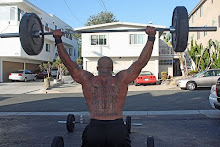
On August 8th 2009, I ruptured my left Achilles tendon while working out. I wasn't doing anything wrong or dangerous, I was doing box jumps. I didn't land wrong or awkward. It just sometimes happens. Here are some things I think people should know about Achilles tendon injuries and your options should it happen to you.
Acute Achilles Tendon Rupture
Rupture, or tearing, of the Achilles tendon is a common condition. This typically occurs in the unconditioned individual who sustains the rupture while playing sports, or perhaps, from tripping. There is a vigorous contraction of the muscle and the tendon tears. The patient will often describe the sensation that someone or something has hit the back of the calf muscle. Pain is suddenly present, and although it is possible to walk, it is usually painful. More importantly however, the leg is weak. This is particularly noticeable when trying to push off while walking, and there is not sufficient strength to do so.
Non surgical care
While it is possible to treat this ruptured tendon without surgery, this is not ideal since the maximum strength of the muscle and tendon rarely returns. The reason for this is that the ends of the tendon are ruptured in a very irregular manner, almost like the ends of a paint brush. As soon as the tendon ruptures, the calf muscle (gastrocnemius muscle) continues to pull on the tendon, and the end of the ruptured tendon pulls back into the leg, which we call retraction. Once the tendon retracts, it is never possible to get sufficient strength back without surgery, because the muscle no longer functions at the correct bio mechanical length, and is now stretched out. If for one reason or another your doctor does not recommend surgery, it is essential to obtain special tests to check that the ends of the tendon are lying next to each other so that healing can occur. The best test to do this is called an ultrasound, and not an MRI. There are patients for whom surgery cannot be performed, in particular, due to existing medical conditions which may add to potential for complications following surgery. For these patients, we use a specially designed boot which positions the foot correctly, and takes the pressure and tension off the muscle and tendon. Most importantly however, a cast is never used because it causes permanent shrinkage (atrophy) of the calf muscle. We use a special boot, which permits pressure on the foot with walking, and a hinge is incorporated into the boot to permit movement of the ankle. We have demonstrated in many studies of rupture of the Achilles tendon, that this movement of the foot in the boot while walking is ideal for tendon healing.
Surgical treatment of Achilles tendon rupture
Surgical correction of the ruptured tendon is almost always necessary. This is performed in order to regain the maximum strength of the Achilles, as well as the normal pushing off strength of the foot. The strength of the muscle depends on the correct tension between the muscle and the tendon. The only way that the correct tension on the tendon can set is by accurately repairing the tendon ends. Take a look at the picture below, and you can see why surgery is necessary. When the tendon ruptures, the ends of the tendon separate and multiple little strands of the tendon are present like pieces of spaghetti.
There are old fashioned techniques for repairing the tendon which require very long incisions (eight inches) on the back of the leg. These are complicated and associated with a high incidence of infection in the skin after surgery. This is an important consideration, since infection in the skin can lead to devastating problems with the skin and tendon. This problem of skin infection has, in the past, led surgeons away from surgical methods of treatment.
Fortunately, now there is a new, unique method available for operating on and repairing the tendon. This new method requires only a tiny incision of one to two centimeters in length. This is far more accurate surgery. Recovery after this procedure is easier and the surgical complication rate is extremely low.
Rehabilitation after Achilles tendon surgery
Following the tendon repair no walking on the foot is permitted for ten days. Then walking is begun in a removable boot. There were some treatments used many years ago that relied upon a leg cast. This led to tremendous weakness and atrophy of muscle that was often permanent. Approximately fifteen years ago, with a treatment pioneered by Dr. Myerson, the recovery after surgery for repairing the Achilles tendon changed dramatically, leading to maximum restoration of tendon healing and rapid return of strength. Instead of a cast, a removable boot is worn and instead of using crutches, walking is commenced very rapidly after surgery. Therapy and exercises are begun soon after surgery. This therapy process is critical in the recovery after tendon rupture, and without a carefully monitored program, full recovery is never possible. This treatment has made a huge difference in the recovery process for both recreational and professional athletes.
This is an article from the Institute of Foot and Ankle Reconstruction at Mercy's



Holy hell I just threw up in my mouth. There is something about snapping that just makes me violently ill. I can watch surgery, birth, anything mostly. But, anytime I hear of something snapping, you can count on me being near a trash can throwing up.
ReplyDelete